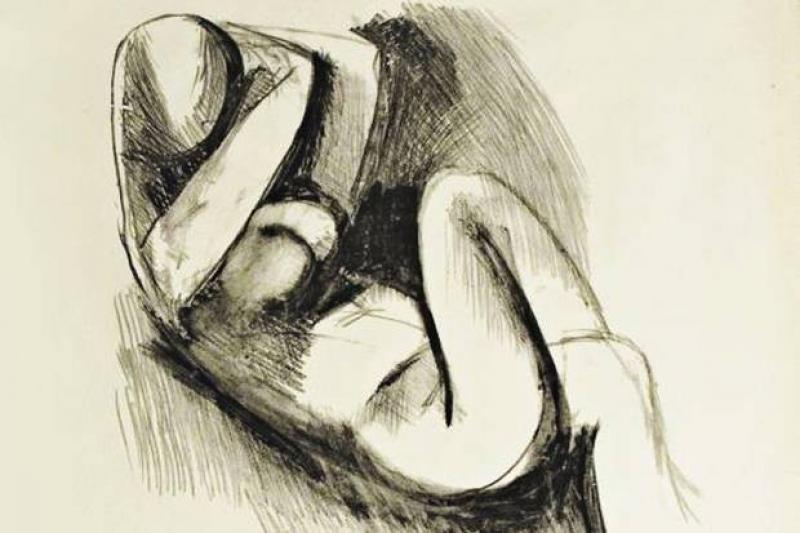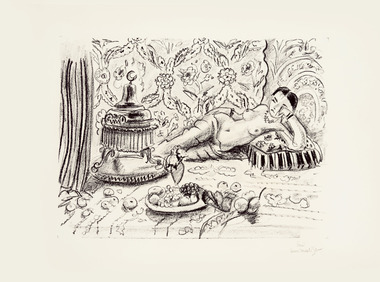Matisse: The Essence of Line, Marlborough Fine Art | reviews, news & interviews
Matisse: The Essence of Line, Marlborough Fine Art
Matisse: The Essence of Line, Marlborough Fine Art
Prints that show off the French artist's extraordinary range and skill, wit and playfulness

The photographs of Henri Matisse at work show, over the years, a sober, suited, bearded and dignified figure; there is also a charming series of Matisse in a white coat, as though he were a doctor, sitting in his studio and thoughtfully examining in close-up a curvaceous naked young woman, his model. In his maturity, he looks almost like the stereotype of the upper middle class professional, the lawyer that he once almost was.
Of course, what happened is that he became, against family opposition and with an almost life-long struggle, one of the most dominant and adored artists of the last century. Belying his unusually conventional appearance, he was an artist peculiarly gifted at conveying a complex yet paradoxically almost innocent celebration of the most profound sensuality, whether directed at a vase of flowers, a captivating interior, a landscape glimpsed through a window, people sitting in a garden, and above all else, women, both clothed and unclothed.
It is intriguing, even irresistible, to be so convinced by his extraordinary wit and playfulness with minimal means
The current show of prints at Marlborough Fine Art shows us just this last aspect. Here is Matisse at his finest as a magical art conjurer: a handful of curving lines, a smudge of shadow and shading, and a seductive, plump odalisque appears, relaxed sexuality incarnate.
Matisse made some 800 prints in his lifetime as well as illustrating some superb artists’ books – livres d’artiste in the French tradition. A very fine selection is on view in this museum-worthy show, curated by the Picasso scholar Marilyn McCully, showing us in about 50 examples the extraordinary range and skill of his visual imagination.
Imagery is almost exclusively restricted to renderings of the artist’s models, languorous creatures, reclining in positions so flexible it is as though these voluptuous creatures have not a bone in their body; or casually stretching their well-rounded bodies in unselfconscious poses, happy in their bodily selves. (Below: Odalisque, brasero et coupe de fruits, 1929)
 Here Matisse is the master of line. It is intriguing, even irresistible, to be so convinced by his extraordinary wit and playfulness with minimal means – a dozen lines or so to convey a fully fleshed out female body. And in black and white, Matisse also manages to convey the colourful patterns of the textiles he collected and adored, as backgrounds to the women draped every which way, sitting, lying, whimsical, wistful, alluring, insouciant, a huge spectrum of moods persuasively visualised. Great swathes of shadow, particularly in the portraits of women all dressed up, make convincing depths to the images.
Here Matisse is the master of line. It is intriguing, even irresistible, to be so convinced by his extraordinary wit and playfulness with minimal means – a dozen lines or so to convey a fully fleshed out female body. And in black and white, Matisse also manages to convey the colourful patterns of the textiles he collected and adored, as backgrounds to the women draped every which way, sitting, lying, whimsical, wistful, alluring, insouciant, a huge spectrum of moods persuasively visualised. Great swathes of shadow, particularly in the portraits of women all dressed up, make convincing depths to the images.
He was also an inveterate explorer: he began with etchings and drypoints, set up his own printing press and expanded his technical expertise and collaborations with printers with lithographs, linocuts, and the famed illustrated books.
All is not only in the fascinating spectrum of blacks, whites, deep greys on white and ivory papers. In the wintery greyness of the English winter, one glorious sunshine burst of inventive form and colour, brilliantly integrated, can be seen in the dancing forms based on his cut outs, when illness affected his sustained ability to consistently wield brush and pencil, and he turned to scissors and coloured papers, for his book Jazz (published 1947). A sense of life captured comes across in the abstracted images of Jazz suggestive of menageries, and circuses.
What is also unusually vivid in this concentrated anthology is Matisse’s immersion in dance, not only as a designer for ballet, and a knowledgeable admirer of the skills of dancers, but in his deployment of the expressive possibilities offered by an understanding of rhythm. Beat, pulse, pause are evident in images created over 50 years, in which joyful exuberance is tempered by an acute sensibility concerned to capture the essence of a living, breathing being.
Explore topics
Share this article
The future of Arts Journalism
You can stop theartsdesk.com closing!
We urgently need financing to survive. Our fundraising drive has thus far raised £49,000 but we need to reach £100,000 or we will be forced to close. Please contribute here: https://gofund.me/c3f6033d
And if you can forward this information to anyone who might assist, we’d be grateful.

Subscribe to theartsdesk.com
Thank you for continuing to read our work on theartsdesk.com. For unlimited access to every article in its entirety, including our archive of more than 15,000 pieces, we're asking for £5 per month or £40 per year. We feel it's a very good deal, and hope you do too.
To take a subscription now simply click here.
And if you're looking for that extra gift for a friend or family member, why not treat them to a theartsdesk.com gift subscription?
more Visual arts
 'We are bowled over!' Thank you for your messages of love and support
Much-appreciated words of commendation from readers and the cultural community
'We are bowled over!' Thank you for your messages of love and support
Much-appreciated words of commendation from readers and the cultural community
 Folkestone Triennial 2025 - landscape, seascape, art lovers' escape
Locally rooted festival brings home many but not all global concerns
Folkestone Triennial 2025 - landscape, seascape, art lovers' escape
Locally rooted festival brings home many but not all global concerns
 Sir Brian Clarke (1953-2025) - a personal tribute
Remembering an artist with a gift for the transcendent
Sir Brian Clarke (1953-2025) - a personal tribute
Remembering an artist with a gift for the transcendent
 Emily Kam Kngwarray, Tate Modern review - glimpses of another world
Pictures that are an affirmation of belonging
Emily Kam Kngwarray, Tate Modern review - glimpses of another world
Pictures that are an affirmation of belonging
 Kiefer / Van Gogh, Royal Academy review - a pairing of opposites
Small scale intensity meets large scale melodrama
Kiefer / Van Gogh, Royal Academy review - a pairing of opposites
Small scale intensity meets large scale melodrama
 Jenny Saville: The Anatomy of Painting, National Portrait Gallery review - a protégé losing her way
A brilliant painter in search of a worthwhile subject
Jenny Saville: The Anatomy of Painting, National Portrait Gallery review - a protégé losing her way
A brilliant painter in search of a worthwhile subject
 Abstract Erotic, Courtauld Gallery review - sculpture that is sensuous, funny and subversive
Testing the boundaries of good taste, and winning
Abstract Erotic, Courtauld Gallery review - sculpture that is sensuous, funny and subversive
Testing the boundaries of good taste, and winning
 Edward Burra, Tate Britain review - watercolour made mainstream
Social satire with a nasty bite
Edward Burra, Tate Britain review - watercolour made mainstream
Social satire with a nasty bite
 Ithell Colquhoun, Tate Britain review - revelations of a weird and wonderful world
Emanations from the unconscious
Ithell Colquhoun, Tate Britain review - revelations of a weird and wonderful world
Emanations from the unconscious
 Rachel Jones: Gated Canyons, Dulwich Picture Gallery review - teeth with a real bite
Mouths have never looked so good
Rachel Jones: Gated Canyons, Dulwich Picture Gallery review - teeth with a real bite
Mouths have never looked so good
 Yoshitomo Nara, Hayward Gallery review - sickeningly cute kids
How to make millions out of kitsch
Yoshitomo Nara, Hayward Gallery review - sickeningly cute kids
How to make millions out of kitsch
 Hamad Butt: Apprehensions, Whitechapel Gallery review - cool, calm and potentially lethal
The YBA who didn’t have time to become a household name
Hamad Butt: Apprehensions, Whitechapel Gallery review - cool, calm and potentially lethal
The YBA who didn’t have time to become a household name

Add comment